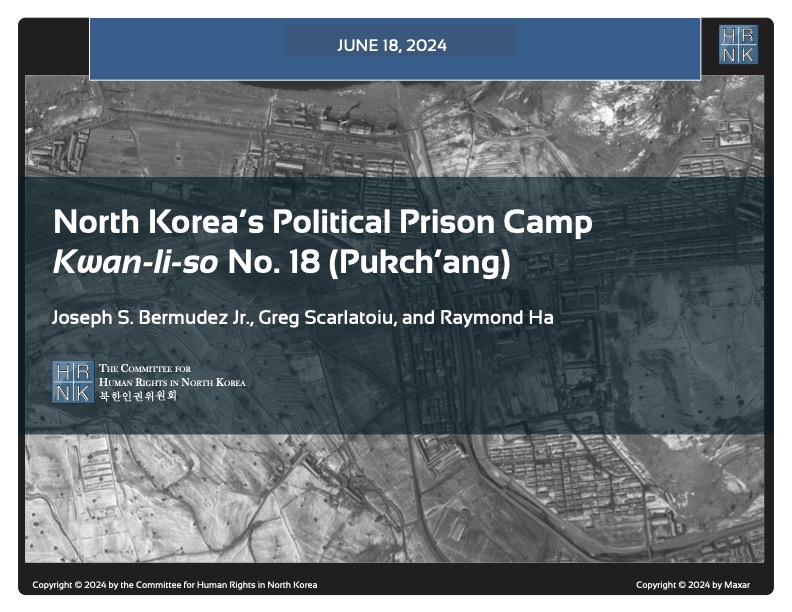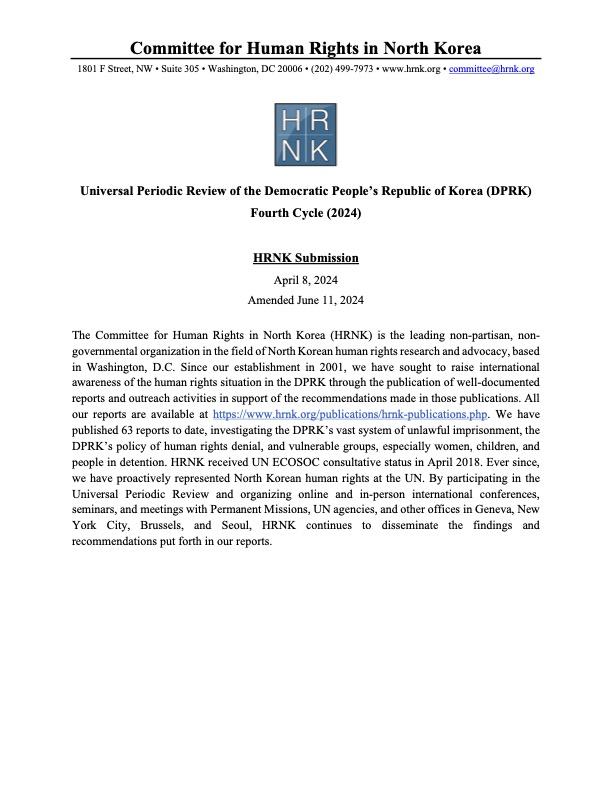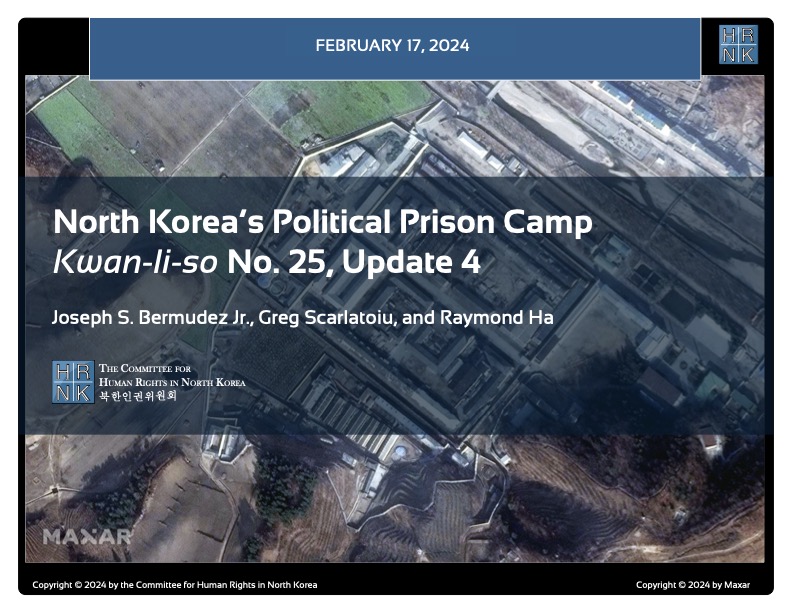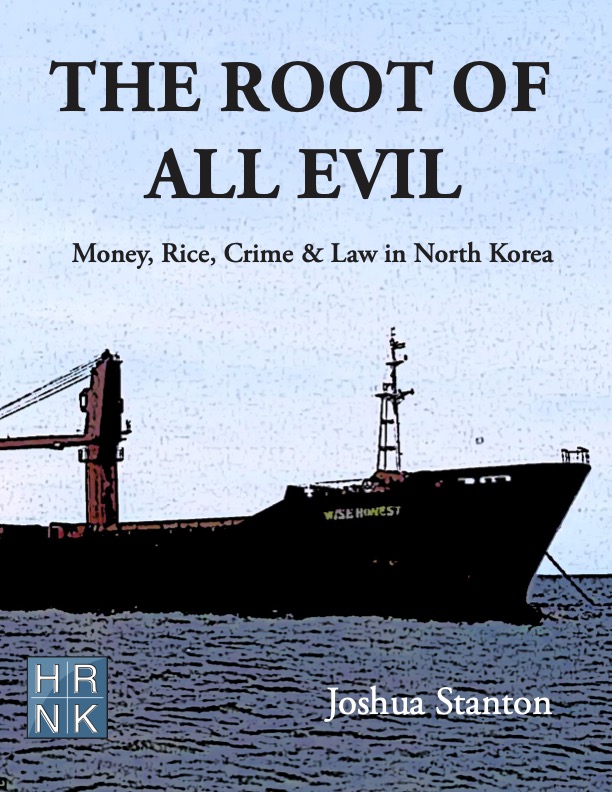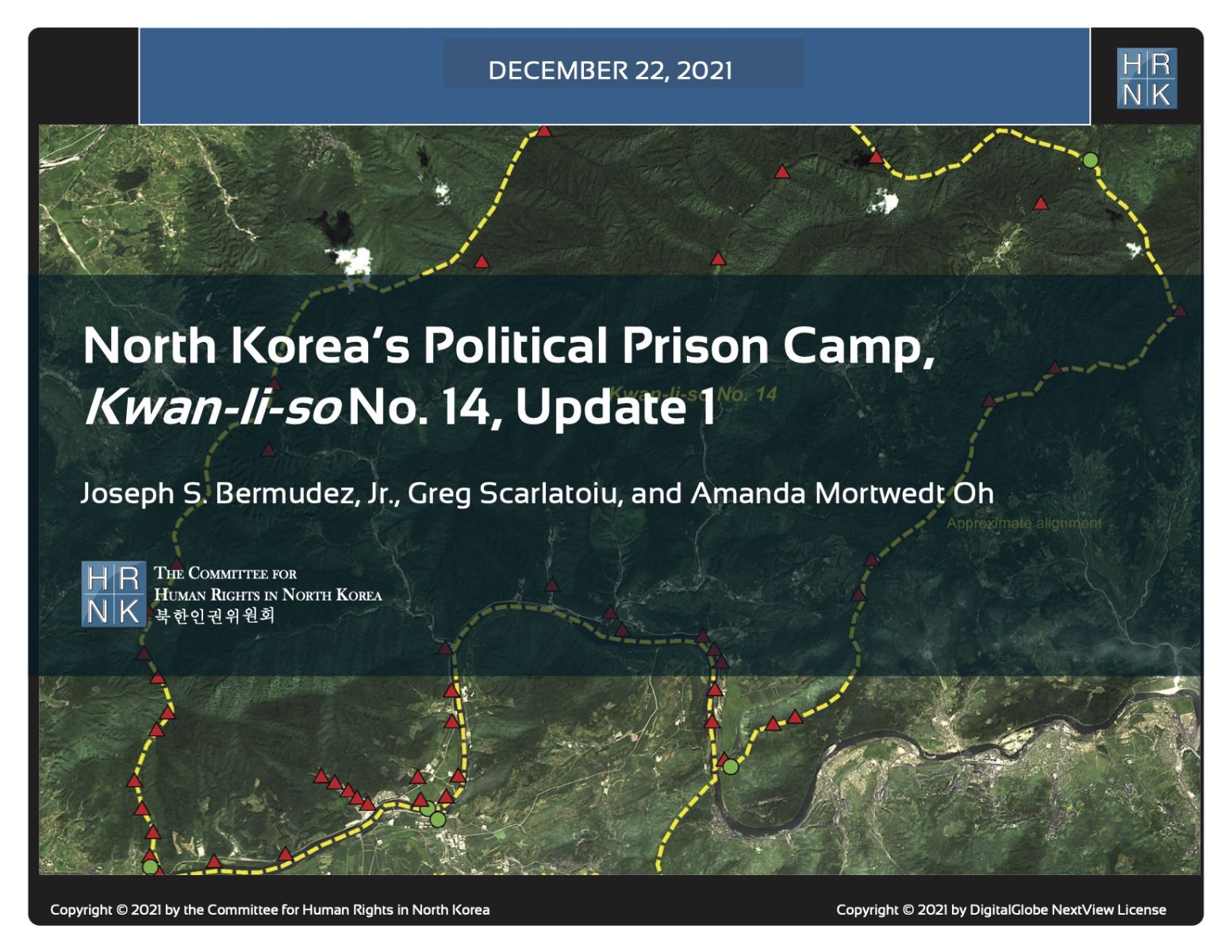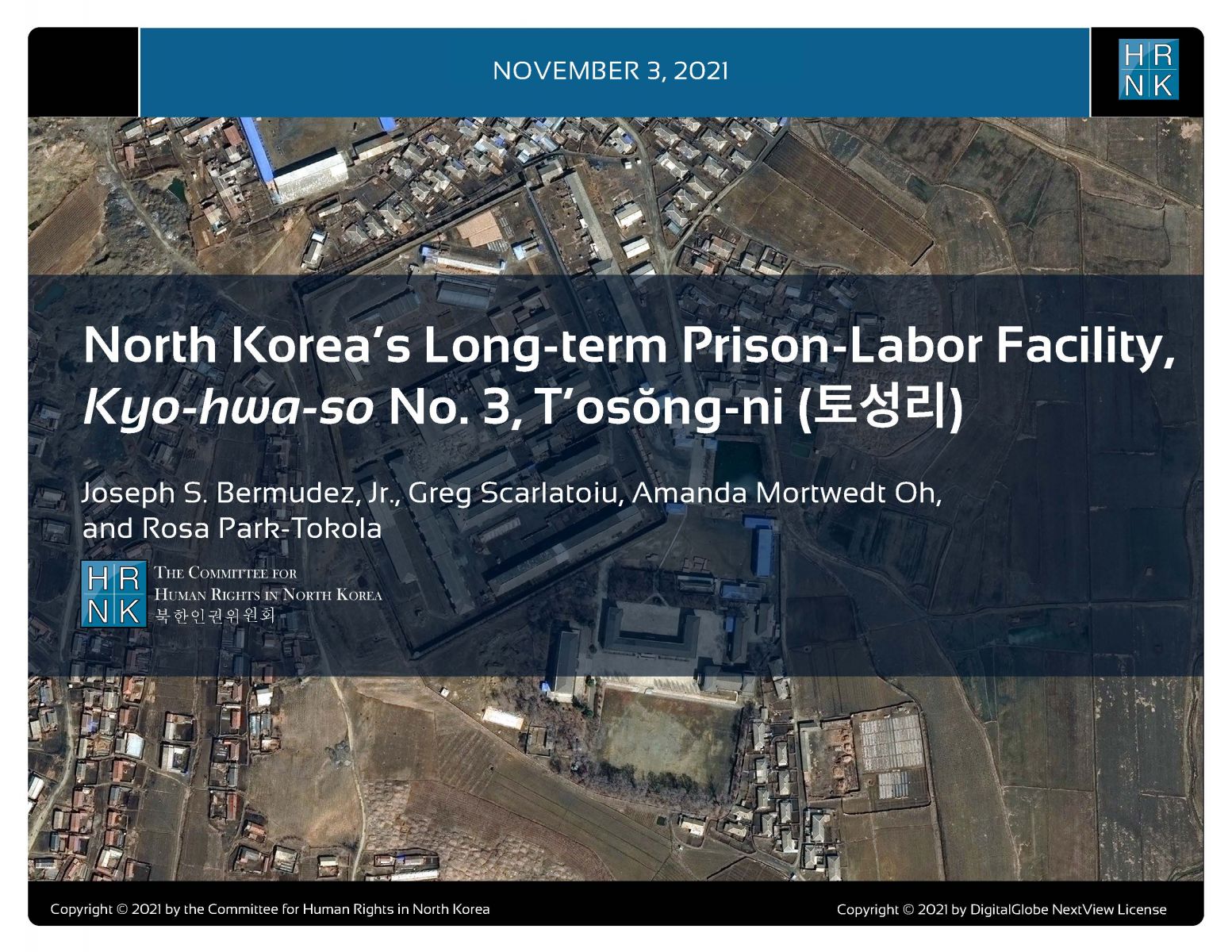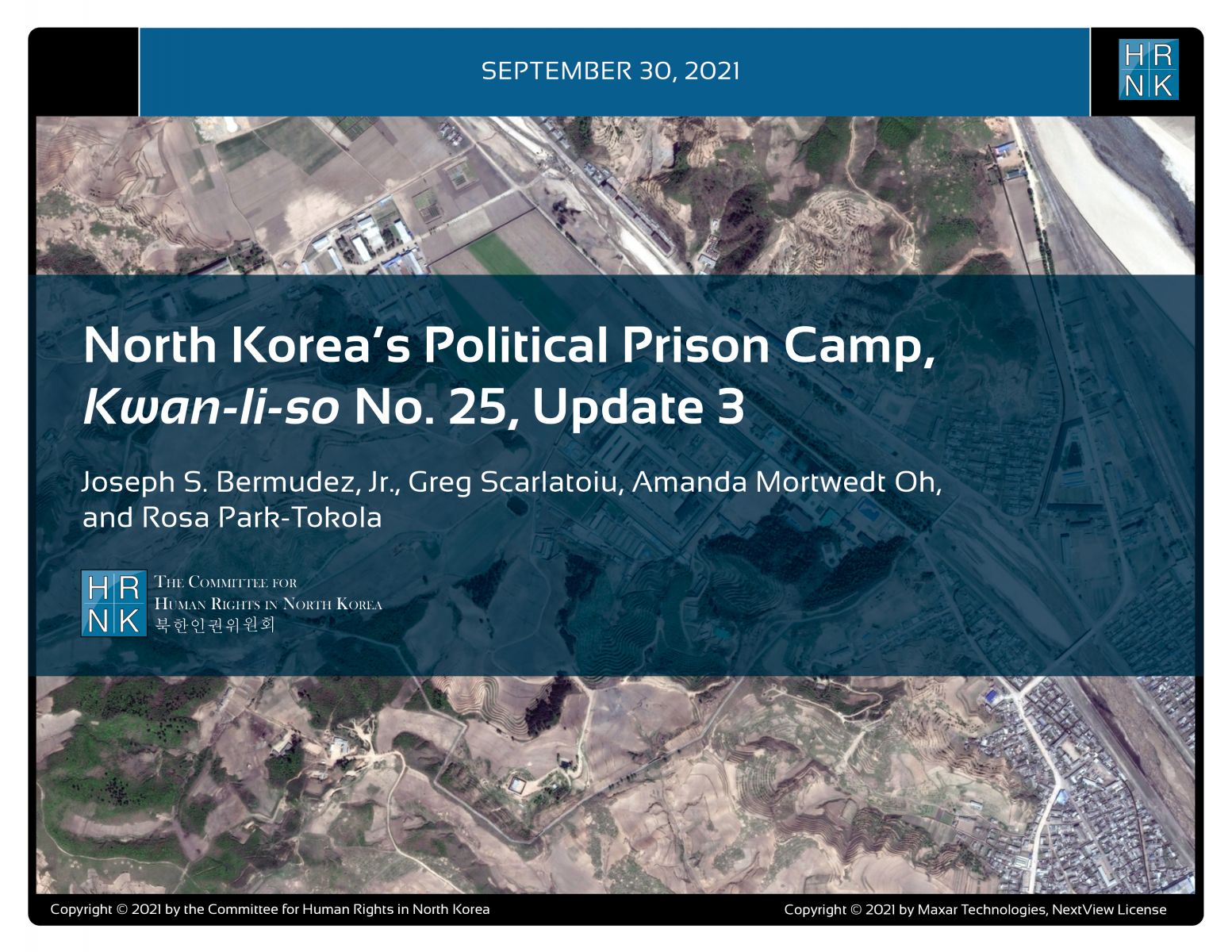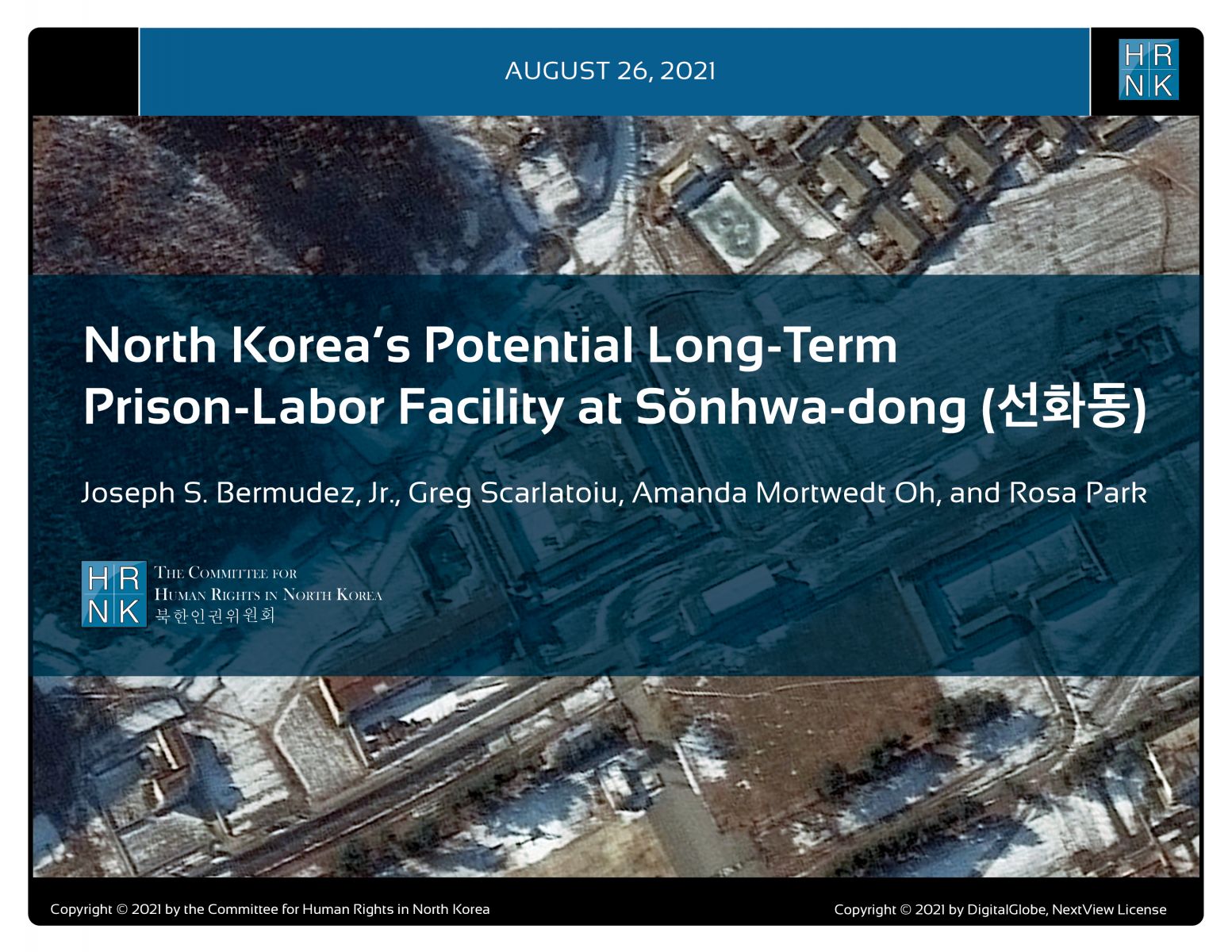PRESS RELEASE
Monday, November 30, 2015
The Committee for Human Rights in North Korea (HRNK) and AllSource Analysis (AllSource) Launch Report Based on Satellite Imagery of North Korea’s Political Prison Camp No. 14
The Increased Economic Importance of Political Prison Camp Labor, a Developing Trend?
The Committee for Human Rights in North Korea (HRNK), a non-governmental organization based in Washington, D.C. and AllSource Analysis (AllSource), a leading global provider of high-resolution earth imagery solutions, have launched a report entitled North Korea Imagery Analysis of Camp 14. Political Prison Camp No. 14 (a.k.a. Kwan-li-so No. 14) is located approximately 61 kilometers northeast of North Korea’s capital city of Pyongyang and about 19 kilometers southeast of Kaechon, South Pyongan Province.
Located on the forested slopes of the Changan mountain range, Camp 14 was established in the mid-1960s. The camp occupies an irregularly shaped area that measures approximately 14 by 21 kilometers. While open-source information on the camp continues to be scarce, the Camp 14 political prisoner population is estimated to be around 15,000. The report can be downloaded from HRNK’s website (HRNK.ORG), together with other HRNK publications. For this report, AllSource used pan-sharpened satellite imagery collected by DigitalGlobe, Airbus Defense and Space and Landsat from December 2002 through December 2014. The report also used declassified KH-9 satellite imagery in order to provide limited historical context.
The report is the latest step in a collaborative effort by HRNK and AllSource to create a clear picture of the evolution and current state of North Korea’s political prison camps. HRNK is the NGO that put North Korea’s penal labor colonies on the map by publishing Hidden Gulag in 2003, Hidden Gulag Second Edition in 2012, North Korea’s Hidden Gulag: Interpreting Reports of Changes in the Prison Camps in 2013, and The Hidden Gulag IV: Gender Repression & Prisoner Disappearances in 2015, all authored by world-renowned investigator David Hawk. Together, the two organizations have been closely monitoring North Korea’s political prison camps so that any attempts to distort the harsh reality of the camps by destroying evidence will not go unnoticed.
The new HRNK/AllSource report establishes that Camp No. 14 remains an operational political prison camp. Based on the physical security measures observed, the majority of those inside the camp perimeter are prisoners. Satellite imagery analysis indicates that the prisoners maintain the agricultural fields, orchards, and livestock. Prisoners are forced to work in logging and the manufacturing of wood products. They are also dispatched as forced laborers at light industrial facilities and mines.
It appears that significant road repair and construction activity has been conducted during the period under study. A new 3-kilometer-long road, constructed between September 2013 and December 2014, provides access to support new agricultural and logging activity. While the prisoner population appears to have remained constant, the new road construction activity seems to provide evidence of the sustained, if not increased economic significance of Camp 14 and its slave laborers.
HRNK Executive Director Greg Scarlatoiu said: “Ever since HRNK began investigating the North Korean gulag, it became apparent that the use of forced labor was extensive. The death rates in the camps are high, as prisoners are subjected to relentless forced labor and induced malnutrition. It has been difficult to assess the precise economic benefits extracted by the North Korean regime and the officials running the camps from the forced labor of prisoners equipped only with rudimentary tools.” Scarlatoiu further added: “The HRNK/AllSource report on North Korea’s camp 14 indicates that that the economic significance of that unlawful detention facility may have increased during the period under study. A previous HRNK/AllSource report on Camp 25 prison labor yielded similar satellite imagery-based findings. By providing updates on all known political prison camps in North Korea through satellite imagery analysis and defector testimony, HRNK and AllSource will endeavor to assess if the increased economic importance of the political prison camps and the slave labor they provide is a developing trend under the regime of Kim Jong-un.”
The report North Korea’s Camp No. 14 is available on HRNK’s website: WWW.HRNK.ORG
Contact: Greg Scarlatoiu, [email protected]; 202-499-7973
This is the first satellite imagery report by HRNK on a long-term political prison commonly identified by researchers and former detainees as Kwan-li-so No. 18 (Pukch'ang).
This report was concurrently published on Tearline at https://www.tearline.mil/public_page/prison-camp-18.
To understand the challenges faced by the personnel who are involved in North Korea’s nuclear program, it is crucial to understand the recruitment, education, and training processes through the lens of human rights. This report offers a starting point toward that understanding.
North Korea’s scientists and engineers are forced to work on the nuclear weapons program regardless of their own interests, preferences, or aspirations. These individuals may be described as “moder
In this submission, HRNK focuses its attention on the following issues in the DPRK:
- The status of the system of detention facilities, where a multitude of human rights violations are ongoing.
- The post-COVID human security and human rights status of North Korean women, with particular attention to sexual and gender-based violence (SGBV).
- The issue of Japanese abductees and South Korean prisoners of war (POWs), abductees, and unjust detainees.
This report provides an abbreviated update to our previous reports on a long-term political prison commonly identified by former prisoners and researchers as Kwan-li-so No. 25 by providing details of activity observed during 2021–2023.
This report was originally published on Tearline at https://www.tearline.mil/public_page/prison-camp-25.
This report explains how the Kim regime organizes and implements its policy of human rights denial using the Propaganda and Agitation Department (PAD) to preserve and strengthen its monolithic system of control. The report also provides detailed background on the history of the PAD, as well as a human terrain map that details present and past PAD leadership.
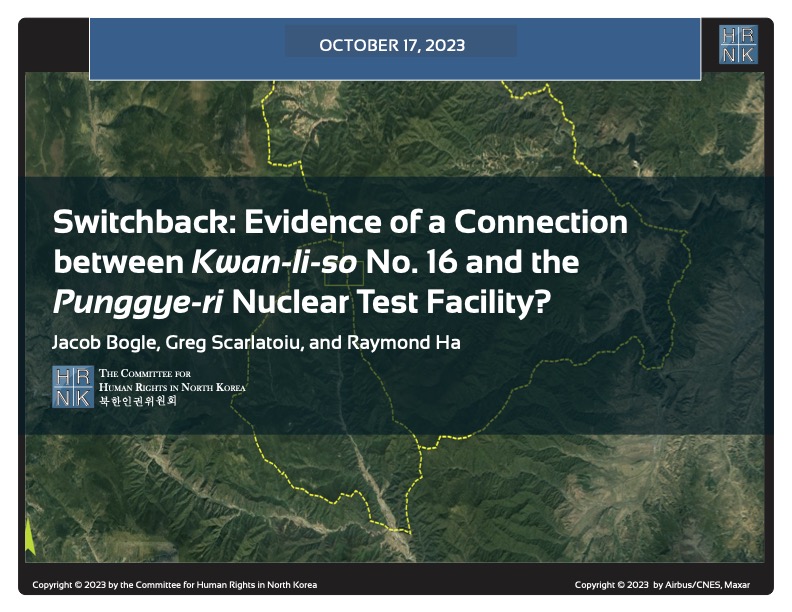
HRNK's latest satellite imagery report analyzes a 5.2 km-long switchback road, visible in commercial satellite imagery, that runs from Testing Tunnel No. 1 at North Korea's Punggye-ri nuclear test facility to the perimeter of Kwan-li-so (political prison camp) no. 16.
This report proposes a long-term, multilateral legal strategy, using existing United Nations resolutions and conventions, and U.S. statutes that are either codified or proposed in appended model legislation, to find, freeze, forfeit, and deposit the proceeds of the North Korean government's kleptocracy into international escrow. These funds would be available for limited, case-by-case disbursements to provide food and medical care for poor North Koreans, and--contingent upon Pyongyang's progress
For thirty years, U.S. North Korea policy have sacrificed human rights for the sake of addressing nuclear weapons. Both the North Korean nuclear and missile programs have thrived. Sidelining human rights to appease the North Korean regime is not the answer, but a fundamental flaw in U.S. policy.
(Published by the National Institute for Public Policy)
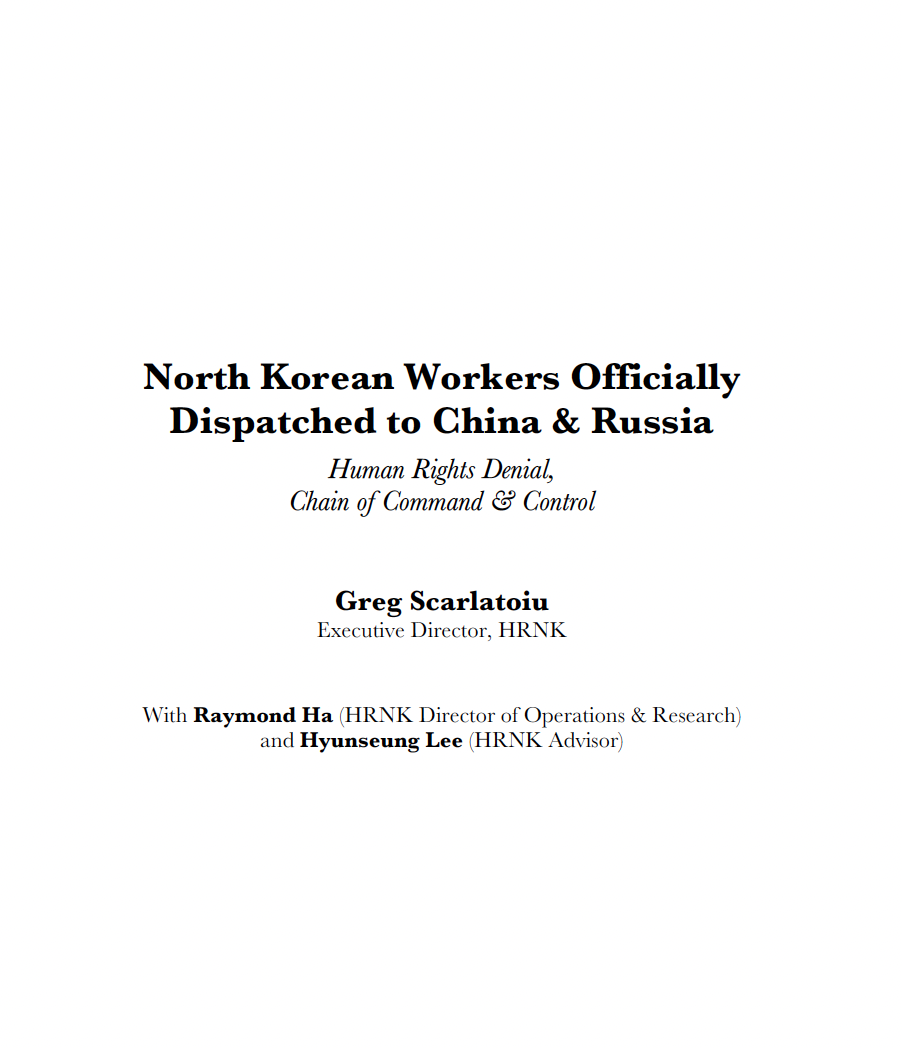
North Korea’s forced labor enterprise and its state sponsorship of human trafficking certainly continued until the onset of the COVID pandemic. HRNK has endeavored to determine if North Korean entities responsible for exporting workers to China and Russia continued their activities under COVID as well.
George Hutchinson's The Suryong, the Soldier, and Information in the KPA is the second of three building blocks of a multi-year HRNK project to examine North Korea's information environment. Hutchinson's thoroughly researched and sourced report addresses the circulation of information within the Korean People's Army (KPA). Understanding how KPA soldiers receive their information is needed to prepare information campaigns while taking into account all possible contingenc
This report is part of a comprehensive long-term project undertaken by HRNK to use satellite imagery and former prisoner interviews to shed light on human suffering in North Korea by monitoring activity at political prison facilities throughout the nation. This is the second HRNK satellite imagery report detailing activity observed during 2015 to 2021 at a prison facility commonly identified by former prisoners and researchers as “Kwan-li-so No. 14 Kaech’ŏn” (39.646810, 126.117058) and
This report is part of a comprehensive long-term project undertaken by HRNK to use satellite imagery and former prisoner interviews to shed light on human suffering in North Korea by monitoring activity at civil and political prison facilities throughout the nation. This study details activity observed during 1968–1977 and 2002–2021 at a prison facility commonly identified by former prisoners and researchers as "Kyo-hwa-so No. 3, T'osŏng-ni" and endeavors to e
This report is part of a comprehensive long-term project undertaken by HRNK to use satellite imagery and former detainee interviews to shed light on human suffering in the Democratic People’s Republic of Korea (DPRK, more commonly known as North Korea) by monitoring activity at political prison facilities throughout the nation. This report provides an abbreviated update to our previous reports on a long-term political prison commonly identified by former prisoners and researchers as Kwan-li-so<
Through satellite imagery analysis and witness testimony, HRNK has identified a previously unknown potential kyo-hwa-so long-term prison-labor facility at Sŏnhwa-dong (선화동) P’ihyŏn-gun, P’yŏngan-bukto, North Korea. While this facility appears to be operational and well maintained, further imagery analysis and witness testimony collection will be necessary in order to irrefutably confirm that Sŏnhwa-dong is a kyo-hwa-so.
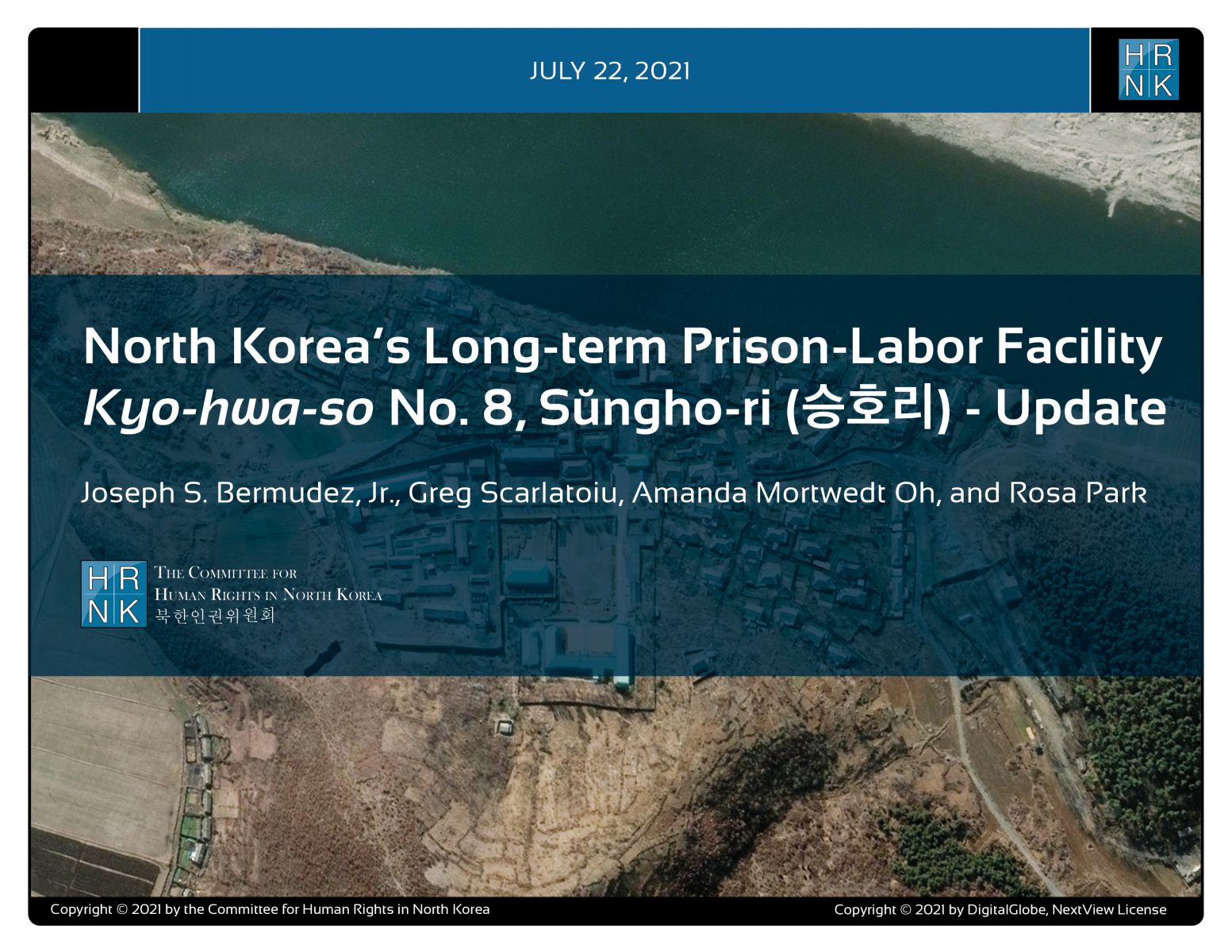
"North Korea’s Long-term Prison-Labor Facility Kyo-hwa-so No. 8, Sŭngho-ri (승호리) - Update" is the latest report under a long-term project employing satellite imagery analysis and former political prisoner testimony to shed light on human suffering in North Korea's prison camps.
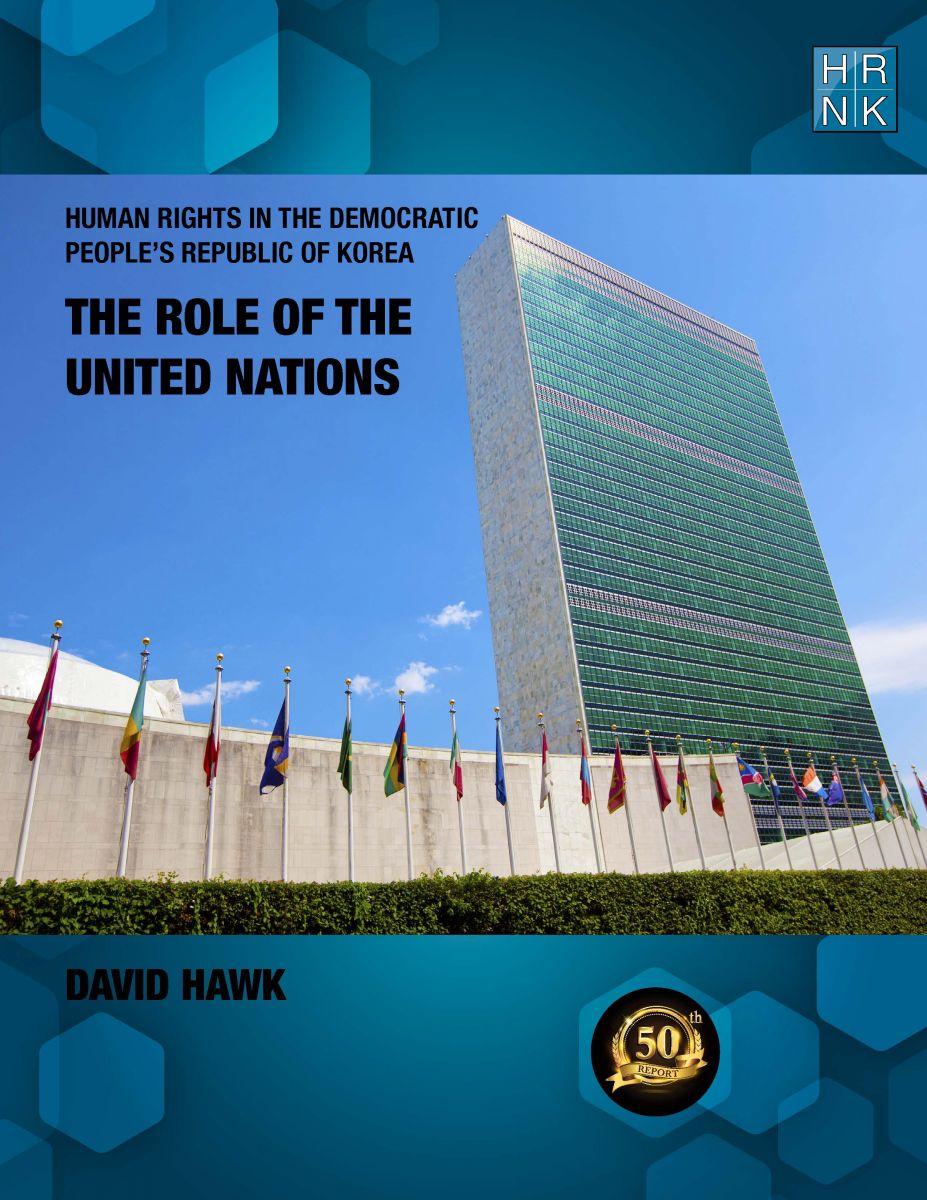
Human Rights in the Democratic Republic of Korea: The Role of the United Nations" is HRNK's 50th report in our 20-year history. This is even more meaningful as David Hawk's "Hidden Gulag" (2003) was the first report published by HRNK. In his latest report, Hawk details efforts by many UN member states and by the UN’s committees, projects and procedures to promote and protect human rights in the DPRK. The report highlights North Korea’s shifts in its approach
South Africa’s Apartheid and North Korea’s Songbun: Parallels in Crimes against Humanity by Robert Collins underlines similarities between two systematically, deliberately, and thoroughly discriminatory repressive systems. This project began with expert testimony Collins submitted as part of a joint investigation and documentation project scrutinizing human rights violations committed at North Korea’s short-term detention facilities, conducted by the Committee for Human Rights
